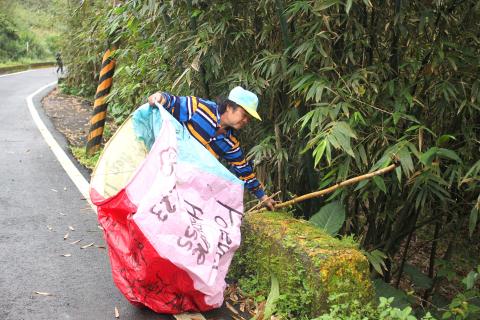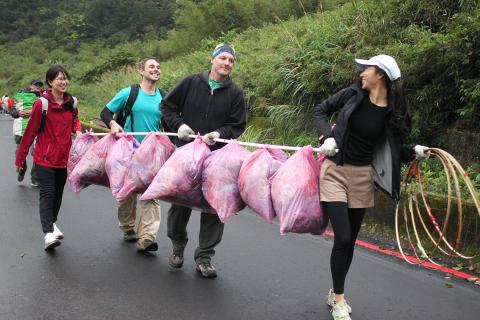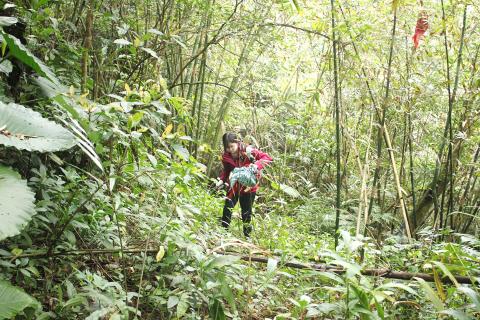An afternoon picking up fallen sky lanterns in New Taipei City's Pingsi District (平溪) with volunteers organized by Taiwan Adventure Outings, an outdoor education company, is a Sisyphean task that I won’t soon forget.
As we fill up trash bag after trash bag on the ground, the overcast sky reveals a continuing parade of lanterns making their inevitable descent.
The 21st Pingsi Sky Lantern Festival had just taken place over two days on Feb. 16 and Feb. 19, the latter being the 15th day of the Lunar New Year, which families traditionally commemorate by carrying lanterns and solving lantern riddles.
.jpg)
Photo: Davina Tham, Taipei Times
The sky lantern as an emblem of Chinese culture, coupled with an inexpensive price tag starting at NT$100, makes for a potent tourist attraction that the New Taipei City Government encourages as a must-do activity. The most popular and picturesque location from which to release a sky lantern is the train track along Shifen Old Street (十分老街).
WHERE DO LANTERNS GO WHEN THEY DIE?
So on a gray Saturday morning, I woke early and endured a whiplashing, almost hour-long, standing room-only bus ride on winding hillside roads from Taipei, to answer a question about which I have long wondered: What happens to sky lanterns when they fall?

Photo: Davina Tham, Taipei Times
My initial theories are sophisticated, because they accommodate naive optimism. Maybe lanterns rise high enough to burn up in the Earth’s atmosphere, so the ashes can float down and replenish nutrients in the soil. Maybe lantern manufacturers these days use 100 percent biodegradable materials. Maybe lanterns make landfall within a known radius of the train tracks, and cleaners are dispatched to locate and dispose of them swiftly.
There is a bit of truth in each hypothesis, but not enough.
Some lanterns burn up when their internal flames catch the combustible lining, but others fall to the ground intact. Some lantern parts are made of biodegradable paper and bamboo, but the paper is painted and treated with chemicals, and can take months to disintegrate. Everyone can certainly see where the lanterns fall, but city authorities and cleaners do not always have the resources to clear them, especially from less accessible locations.

Photo: Davina Tham, Taipei Times
When sky lanterns fall, they fall randomly, with no regard for the best of human intentions that have been written on their paper skins. They indiscriminately pepper hillsides and river banks, invade backyards and impale themselves on trees.
“The ink on this one isn’t even dry,” joked a fellow volunteer, as we picked up a pristine lantern. The tragicomedic quality of her words is striking. While besotted couples and excitable children penned heartfelt wishes on their sky lanterns, just a few kilometers and minutes away, we found them muddied on the ground, stuffing them unceremoniously into our trash bags. What a bleak metaphor for the futility of human aspirations.
One lantern had fallen squarely on a fish-shaped waterspout in a garden pond, smothering it. Another lantern descended with a flourish onto a tree branch right before us. Its red paper skin glowed, fleshlike, then tore away in charred black tatters. Within seconds, it had been reduced to a bamboo and metal skeleton.

Photo: Davina Tham, Taipei Times
Elderly residents collect the undamaged frames, each of which can be resold to the government-run recycling center for NT$8. It’s the rare environmentally-friendly practice that has stuck, because it makes business sense for the locals.
ENVIRONMENTAL OUTCRY
After years of outcry by environmental groups, the New Taipei City Government has made some attempts to address the environmental costs of the sky lanterns, such as introducing monetary incentives for recycling. But it still bows to the tourism imperative. It is difficult to do otherwise, since sky lanterns support the livelihoods of local shopkeepers, innkeepers, train and bus operators and recycling vigilantes, to name a few.
As with previous years, the city authorities organized their own official sky lantern clean-up on Feb. 24. About 200 people participated. Ironically, the event included a miniature sky lantern decoration segment, as if to whet participants’ appetite for the real thing.
Some concerned citizens are taking matters into their own hands. In 2016, a local start-up, The Culture Bank, made the news for designing lanterns using rice paper, which is readily biodegradable and dissolves in the rain. But higher costs and a stubborn adherence to tradition mean that their lanterns have yet to break into the market.
In the absence of upstream improvements, there continues to be a need for downstream fixes like volunteer clean-ups. In two hours, our band of 25 volunteers picked up 326.15kg of trash. The haul was not limited to lanterns, but also included cigarette packs and recyclable drink bottles and cans.
Despite the Sisyphean effort, there is a sense of achievement knowing that an afternoon of physical labor using the basic functions of my limbs has made a tangible contribution to the environment. It’s enough to make me think I could do it again.
■ On May 25, the 3rd annual Taiwan National Clean-Up Day organized by Taiwan Adventure Outings will take place in 20 locations across the island. To find out about participation or sponsorship opportunities, contact Ryan Hevern at ryan@taoutings.com or (0963) 520-946 and visit: www.facebook.com/groups/TaiwanAdventureOutings/.

Oct. 27 to Nov. 2 Over a breakfast of soymilk and fried dough costing less than NT$400, seven officials and engineers agreed on a NT$400 million plan — unaware that it would mark the beginning of Taiwan’s semiconductor empire. It was a cold February morning in 1974. Gathered at the unassuming shop were Economics minister Sun Yun-hsuan (孫運璿), director-general of Transportation and Communications Kao Yu-shu (高玉樹), Industrial Technology Research Institute (ITRI) president Wang Chao-chen (王兆振), Telecommunications Laboratories director Kang Pao-huang (康寶煌), Executive Yuan secretary-general Fei Hua (費驊), director-general of Telecommunications Fang Hsien-chi (方賢齊) and Radio Corporation of America (RCA) Laboratories director Pan
The consensus on the Chinese Nationalist Party (KMT) chair race is that Cheng Li-wun (鄭麗文) ran a populist, ideological back-to-basics campaign and soundly defeated former Taipei mayor Hau Lung-bin (郝龍斌), the candidate backed by the big institutional players. Cheng tapped into a wave of popular enthusiasm within the KMT, while the institutional players’ get-out-the-vote abilities fell flat, suggesting their power has weakened significantly. Yet, a closer look at the race paints a more complicated picture, raising questions about some analysts’ conclusions, including my own. TURNOUT Here is a surprising statistic: Turnout was 130,678, or 39.46 percent of the 331,145 eligible party

The classic warmth of a good old-fashioned izakaya beckons you in, all cozy nooks and dark wood finishes, as tables order a third round and waiters sling tapas-sized bites and assorted — sometimes unidentifiable — skewered meats. But there’s a romantic hush about this Ximending (西門町) hotspot, with cocktails savored, plating elegant and never rushed and daters and diners lit by candlelight and chandelier. Each chair is mismatched and the assorted tables appear to be the fanciest picks from a nearby flea market. A naked sewing mannequin stands in a dimly lit corner, adorned with antique mirrors and draped foliage

The election of Cheng Li-wun (鄭麗文) as chair of the Chinese Nationalist Party (KMT) marked a triumphant return of pride in the “Chinese” in the party name. Cheng wants Taiwanese to be proud to call themselves Chinese again. The unambiguous winner was a return to the KMT ideology that formed in the early 2000s under then chairman Lien Chan (連戰) and president Ma Ying-jeou (馬英九) put into practice as far as he could, until ultimately thwarted by hundreds of thousands of protestors thronging the streets in what became known as the Sunflower movement in 2014. Cheng is an unambiguous Chinese ethnonationalist,